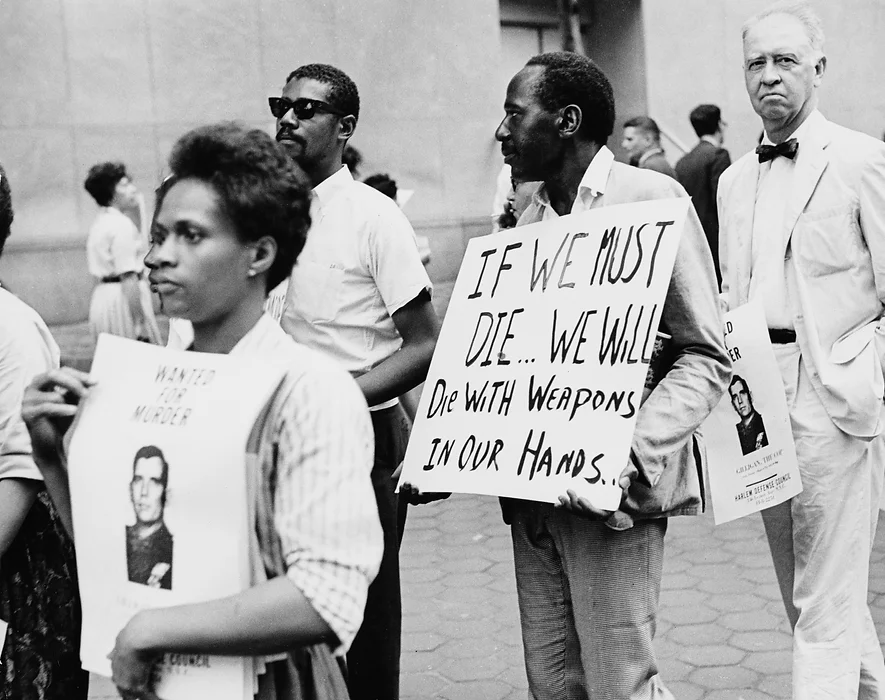Photo by Archive Photos/Stringer/Getty Images
The Incident
On July 16, 1964, Thomas Gilligan, an off-duty New York City police lieutenant, intervened in an argument between James Powell and an apartment building superintendent on East 76th Street. Gilligan alleged that he fatally shot Powell in self-defense as Powell attempted to stab him with a knife. Eyewitnesses claimed that the building superintendent and Gilligan shouted racial epithets at Powell and other teenagers. Witnesses also attested that Powell was unarmed during the confrontation.
Civil rights leaders, Harlem residents, and local journalists insisted that deadly force was not necessary in the encounter between the six-foot-tall, 200-pound Gilligan and the 120-pound teen James Powell.
Immediately following the shooting, nearly 300 Black students in a neighboring summer school gathered to throw bottles, cans, and cement at police officers. Six days of violent demonstrations shook the Harlem and Bedford-Stuyvesant neighborhoods.
A grand jury cleared Gilligan of any wrong-doing and the NYPD Civilian Complaint Review Board absolved him of any responsibility for the murder. As Police Commissioner Michael Murphy explained, the Board “concluded that there were no violations of the rules and procedures of the department.”

Protests at the United Nations Headquarters
An interracial coalition of Harlem residents marched to the United Nations to express their outrage and demand legal redress.
The woman on the left of this photograph carries a sign with Gilligan’s picture reading: “Wanted for Murder—Gilligan the Cop.” Bill Epton, Harlem resident and communist organizer, created and circulated that wanted poster. Outraged city officials declared a State of Emergency that prohibited ongoing demonstrations and Epton was charged and convicted of “criminal anarchy,” the first such conviction since the 1919 Red Scare.
The man behind her carries hand-written sign that alludes to Harlem Renaissance poet Claude McKay’s poem “If We Must Die.” McKay published the poem during the “Red Summer” of 1919, when Black communities confronted the rise of white supremacist intimidation, property damage, and lynching following World War I. McKay urged Black residents to embrace aggressive self-defense to protect their communities. Black residents risked their lives to heed his call.

This willingness to pursue resistance demonstrates the urgency of the crisis. If Harlem residents believed that local police officers would not protect Black youth, some Black residents would risk their lives to protect their communities.
By protesting at the UN headquarters, the activists made the case that American racism was cause for international concern. In New York City, sympathetic media outlets and international deliberative bodies amplified these claims. Critiques of American race relations from UNESCO and others internationally put a spotlight on a wretched failure of American democracy.
The 1964 civil rights protest at the United Nations illustrates the long, ongoing struggle to achieve police reform in the United States. Police oversight was a prominent concern for the Civil Rights movement. James Forman and the Congress of Racial Equality pushed for the creation of independent civilian review boards to hold police accountable for their conduct. These protesters at the UN sought international support for their demands for police accountability.
As Roy Wilkins, Executive Secretary of the National Association for Colored People, expressed the collective outrage: “They can explain and explain until they’re blue in the face, but they’ll never explain why it’s necessary for a police officer to shoot a 15-year-old kid.”

Listen to the author:
Learn More:
Thomas Borstelmann, The Cold War and the Color Line: American Race Relations in the Global Arena (2003).
Martin Arnold, “Police Board Absolves Gilligan In Slaying of Negro Teen-Ager,” New York Times (Nov, 7, 1964), https://www.nytimes.com/1964/11/07/archives/police-board-absolves-gilligan-in-slayin-g-of-negro-teenager-no.html.
David Halberstam, “Jury’s Exoneration of Gilligan Scored by Negro Leaders,” New York Times (Sept. 2, 1964),
https://www.nytimes.com/1964/09/02/archives/jurys-exoneration-of-gilligan-scored-by-negro-leaders.html
Sarah Brady Siff, “Policing the Police: A Civil Rights Story” Origins: Current Events in Historical Perspective (May 2016), https://origins.osu.edu/article/policing-police-civil-rights-story.





